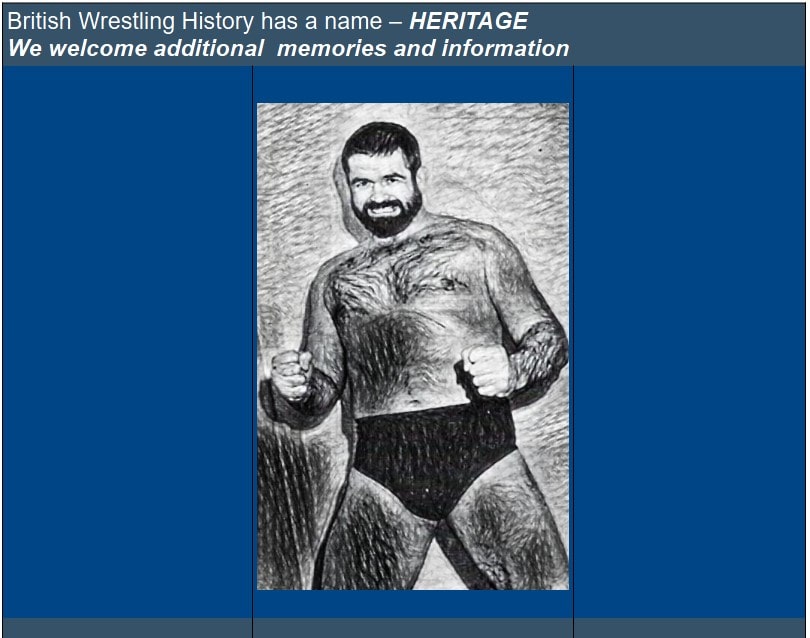Wrestling Heritage welcomes memories, further information and corrections.

By the late 1970s British wrestling was jaded and in need of a boost. Not quite a saviour, but it wasn’t for the want of trying, was a twenty stone, leotarded, bearded and solid Canadian, John Quinn. The posters said he was Mighty. The posters said he was Big. He was both mighty and big.
In contrast to many overseas visitors of the 1970s Quinn was already a well established and successful wrestler at the time of his arrival, having defeated Edouard Carpentier and wrestled, NWA champion Terry Funk and WWWF champion Bruno Sammartino at New York’s Madison Square Garden. This man had credentials as big as his muscles.
His name was already known to British readers of The Wrestler magazine in 1971. Canadian correspondent Bob Leonard had reported on the exploits of Quinn working for Stampede wrestling, trading the North American heavyweight championship with our own Wild Angus Campbell and Les Thornton.
Heritage member and former wrestler Norfolk Snake said: “John Quinn was surely one of, if not the, greatest foreign villains to enter a British ring in the 1980s. DId anyone before or since get as much hateful, venomous heat as this great man? His style and microphone manner, a rare thing in those day, was totally believable.”
John Arthur Quinn was born on 15th October, 1941. He arrived in Britain in January 1979. Almost immediately he was elevated to just about the most hated wrestler in the land following a televised tirade against cowardly Brits, with some promises to eat them alive. This set up the prospect of vengeance for the Brits by Big Daddy Shirley Crabtree, who was receiving an enormous push at the time as Britain’s most popular wrestler.
Whilst Quinn did a splendid job at creating heat we do find his televised opponents during the year rather lacklustre for a man of such ferocity with obvious ability. Jack Rowlands, Barry Douglas, Len Hurst, and Lee Bronson were hardly likely to provide a credible challenge to the Mighty Quinn, with Tony St Clair being the sole exception. Around the halls the likes of St Clair, Pat Roach and Pete Roberts were providing sturdier opposition.
All roads were leading to the showdown with Big Daddy. An unprecedented level of publicity led to an estimated 10,000 fans packing the Wembley Arena on 27th June, 1979. Whilst many in the arena felt satisfied to witness Big Daddy doing what they expected and halting Quinn there were many others that felt the 1 minute 42 second destruction of Big John was one of wrestling’s missed opportunities. A dubious Quinn victory would not have dented Daddy’s status and would have opened up a lucrative return match for Daddy to establish himself as the better man.
Heritage member Powerlock said: “The Crabtrees didn’t have the foresight to give Daddy a hard match or even a defeat, Credibility wasn’t even thought of, a defeat and a win in a hard fought return match might have given him some credibility.” Bill Smith was more direct: “A totally unbelievable show of contempt for the fans who paid to watch live,and for those who saw it on TV.”
As it was, and without coincidence, Quinn’s defeat in a loser must leave the country allowed a timely move to Germany to take part in the German summer tournaments. Of course, the loser to lose the country stipulation was complete nonsense. We wonder where Big Daddy would have gone had he lost?
When Quinn returned at the beginning of 1980 he had Wayne Bridges and his newly acquired World heavyweight title, in his sights. A Quinn victory over Bridges in a non title match at the Royal Albert Hall led to a televised Cup Final championship match in which Quinn won the title when referee Max Ward stopped the contest in his favour. Consequently this led to a high profile match at Wembley Arena in which Bridges and Big Daddy beat Quinn and Yasu Fuji.
The big event of 1980, though, was the tag pairing of John Quinn with Giant Haystacks. It was reassuring to find that the Brit hating Quinn could at least find one decent, principled Brit that he could trust! Their televised match against Pete Roberts and Tarzan Johnny Wilson was even scheduled in the midst of ITV’s Olympic coverage. That must have upset a few Olympic viewers.
And then in the autumn of 1980 one of the biggest wrestling news stories of the year. John and Tony St Clair suddenly left Joint Promotions and went to work for the independents. This was a piviotal moment in British wrestling and in no small measure played a part in the eventual demise of Joint Promotions. To the consternation of Brian Crabtree, the Joint Promotion manager, John Quinn took his championship claim with him, leaving Joint Promotions short of a champion. Quinn, Tony St Clair and Wayne Bridges after he too had joined the independents, were to continue trading the World title until John Quinn lost out to Wayne Bridges for the last time in September, 1986.
He returned to Canada in 1988 and, following a stroke, died in Vancouver on 22nd April, 2019.
A final few words from Norfolk Snake: “It seems a shame that the TV viewers never got to see him battle it out with Pat Roach, Marty Jones, Dalibar Singh and Mark Rocco. Now we can only imagine what bouts they would have been…..In my own brief ring moments I did share a dressing room with him once, and was honoured to meet a seemingly really nice, humble gentleman and a great pro. Shame he didn’t get the chance to sort out Big Daddy“
Page added 21/04/2024
10959
